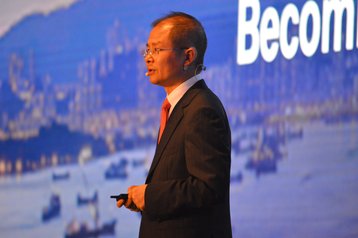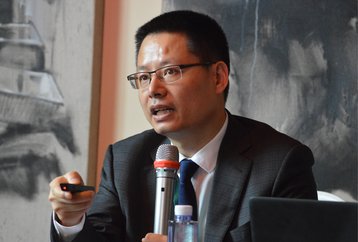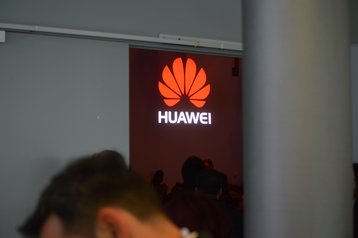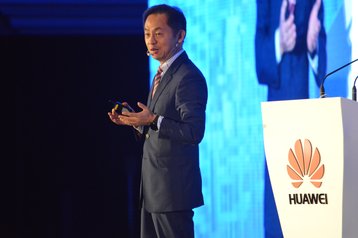Seasoned Huawei watchers will find several key themes recur at any of the company’s many major events.
Terms that mean little - digital transformation, cloudification, ‘the intelligent world’ - are bandied about as company strategies, while a disorientating list of ”memorandum of understanding” partnerships are unveiled as major announcements. Much is made of the firm’s commitment to R&D spend, with little detail on what it classifies as R&D. Executives with absurdly long job titles are wheeled out to give speeches suspiciously similar to ones uttered just months before.
And yet, it does not pay to dismiss Huawei, one of the fastest growing technology companies in the world. Branding and corporate communication may prove difficult for a company whose name still trips up many a tongue, but the cold reality of market share percentages and profit return margins paint the story of a corporation that knows exactly what it is doing.
A digital company
“We see so many companies that vanish just resting on their past laurels,” Eric Xu, Huawei’s outgoing rotating CEO said at its latest global analyst summit in Shenzhen, China, attended by DCD.
Every six months, Huawei switches its rotating CEO mantle between three deputies, while the guiding hand remains its founder Ren Zhengfei, who is also CEO.
Xu continued: “We invest heavily in R&D to sustain Huawei and maintain our leadership in many businesses. About two years ago we made a major change, increasing the investment in basic research.”
For Xu, who is to be succeeded this month by Ken Hu, cloud is a core aspect of Huawei’s overall business. “That is why Huawei has created a cloud business unit, and we are going to invest in it heavily,” he said.
“In the coming years we are going to increase investments in all cloud services,” director and products and solutions president Ryan Ding added.
The cloud business unit was set up in March, under president Zheng Yelai, with a staff of roughly 2,000 and offers 54 full-stack cloud services.
Cloud and proud
“Cloud technology is becoming the new growth engine,” Yelai said. “Huawei has become the preferred partner for many of the world’s top customers and will continue to provide high-quality cloud services with our partners as we persist in building a healthy ecology in the sector.”
And partnerships is exactly the word best used to describe Huawei’s cloud strategy outside of China.
Kevin Hu, president of the company’s enterprise network portfolio, explained to DCD: “In China we have our own public cloud, outside we mainly partner with telecoms companies.”
The Chinese corporation turned to telcos such as Deutsche Telekom and Telefónica - businesses it has a long history with as the world’s largest supplier of telco networking equipment - to offer public cloud services.
“What we want to do is not just provide the pure cloud services, we want to work with telcos to provide a whole suite of services, including connectivity, cloud services, and some other value-added services to the end users,” Hu said.
“Telcos have a natural inherent advantage in providing connectivity, in addition to that, connectivity can be part of the cloud services, and that is one of the reasons we partner with them in some countries to provide cloud services to end users.”
Yelai added that it was time to “strengthen our public cloud offering.”
Working with you, but not with US
When asked about Huawei’s cloud service in relation to AWS and Azure, rotating CEO Xu said: “Both AWS and Microsoft enjoy very strong advantages in the United States and in other developed markets.
“In Europe, by working together with telcos, we can use a local, secure, and trusted public cloud services offering. I believe those are very important considerations as enterprises and organizations in each and every country in Europe pay attention to as they choose Cloud Service providers.”
He added: “In developing markets, I believe that will be an area where Huawei enjoys an advantage because we have an expansive presence and we have very strong capabilities in those markets.
“Therefore we can use the advantages we have accrued over the years and compete with, while coexisting with, both AWS and Microsoft.”
But one of the reasons AWS and Microsoft have strong advantages in the US is simply that they are able to operate in the nation unencumbered by government suspicion. In 2012, a US House of Representatives report claimed Huawei posed a “national security threat” to America, and the corporation was restricted from taking part in national infrastructure projects.
“For the telco business, the US is not a high priority market for Huawei,” Xu said. “For the enterprise business, we’ll grow that business step by step… our strategy and our conditioning there remains unchanged.”
With a new US president who has spouted protectionist and anti-Chinese rhetoric, change may indeed remain elusive.
Speaking to DCD under condition of anonymity, a Huawei employee called the election of Donald Trump a “sad moment, and a difficult one,” but pointed to the President’s recent meeting with Chinese counterpart Xi Jinping as a promising sign. As a major Chinese company, Huawei has a close relationship with Xi, with its staff recently accompanying him to Davos.
A large offering
Despite its issues in the US, Huawei is far from struggling, and has seen record growth in several of its businesses - most recently becoming the world’s third largest server distributor.
This gives the company a crucial advantage over its competitors, Catherine Du, director of marketing at the enterprise business group, said.
“Several vendors can provide one part, some can provide a pipe part, some a cloud part. At Huawei, because we have a very large portfolio, we can provide the whole platform.”
Huawei products are used in over 800 data centers, 420 of which are “cloud based data centers,” Victor Yu, president of industry marketing and solution group at Huawei, told DCD.
“We’re still growing. It’s a good time. It’s a hot time,” Du added.
The company also eyes expansion beyond the data center, to the edge. Its EC-IoT platform hopes to tap into the burgeoning Internet of Things market and the on-location data processing needs that IoT devices necessitate.
Wei Feng, CMO of network solutions, told DCD that the company “sees opportunity in the Chinese government’s Made in China 2025 initiative, also known as smart manufacturing,” which should lead to an uptake in IoT and edge computing usage in the country’s myriad factories.
Outside of China, Huawei has partnered with Schindler to “provide the edge computing competence they need.
“They mainly use edge computing to control escalators and elevators, which have less than 100 sensors. They monitor the machines in real time, so they do not need a huge amount of computing power and storage on the edge computing devices.”
Other companies “may require more power and storage at the source,” Feng said, requiring customized solutions for each business.
But the edge remains just a part of Huawei’s overall cloud offering, Feng stressed. As Huawei’s various arms prepare to tackle the cloud as a whole, hoping to achieve the growth rates the company has become accustomed to, Ryan Ding told DCD: “Cloud is not optional, embracing cloud is what we have to do now.”




